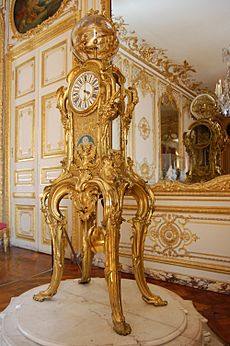Clock Cabinet facts for kids
The Clock Cabinet is a special room inside the famous Versailles Palace in France. It was one of the private rooms used by King Louis XV. The room gets its name from a very impressive astronomical clock that stands there. King Louis XV was very interested in astronomy, which is the study of stars and planets.
The Amazing Astronomical Clock
This incredible clock doesn't just tell the time! It also shows the day of the week, the month, the year, and even the moon's phases. At the very top of the clock, there's a clear crystal globe. Inside, you can see tiny models of the planets moving around the sun. This movement follows the ideas of Copernicus, who discovered that planets orbit the sun, not the Earth.
The clock was designed by Claude-Siméon Passemant, who was the King's engineer. A skilled clock-maker named Louis Dauthiau built the clock itself. The beautiful bronze decorations around the clock were made by Jacques and Philippe II Caffiéri. This clock was so accurate that it helped set the first official time system for the entire kingdom of France! The whole clock is very tall, standing over two meters high.
A King's Interest in Science
The Academy of Science, a group of smart scientists, checked the clock and approved it in August 1749. The Duc de Chaulnes then gave it to King Louis XV on September 7, 1750. The clock was finally placed in the Clock Cabinet in 1754.
The room was actually named "Clock Cabinet" even before this big clock arrived. This was because of other large clock faces built into the wooden walls, called wainscoting. These clocks showed the times of sunrise and moonrise every day. King Louis XV loved science, so he decided to make the room even more special by adding Passemant's amazing astronomical clock.
History of the Room
The Clock Cabinet has changed a lot over the years. In 1692, it was an entrance room and part of King Louis XIV's art collection. In 1738, it was redesigned into a round drawing room. Finally, in 1760, it got its current look.
The beautiful wooden panels on the walls were made by artists named Verberckt and Rousseau. Above the doors, there are copies of paintings that tell stories about the Roman goddess Diana. These were originally painted by a famous artist named Boucher. The room also has special hunting tables that King Louis XV ordered from craftsmen like Slodtz, Foliot, and Roumier. You can also see statues in the room, including one of Frederic II on horseback and a smaller copy of a statue of King Louis XV on horseback.
Gallery




